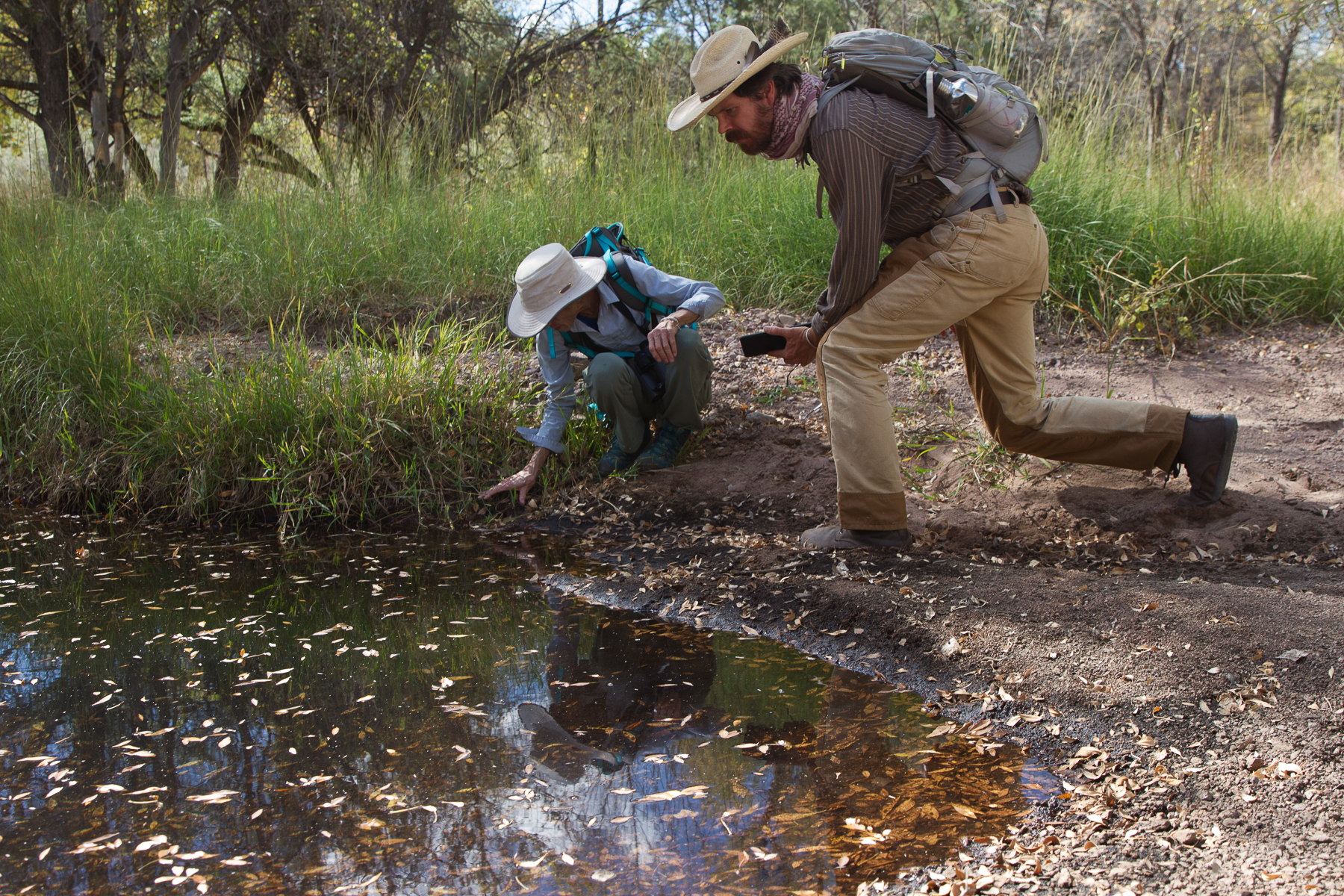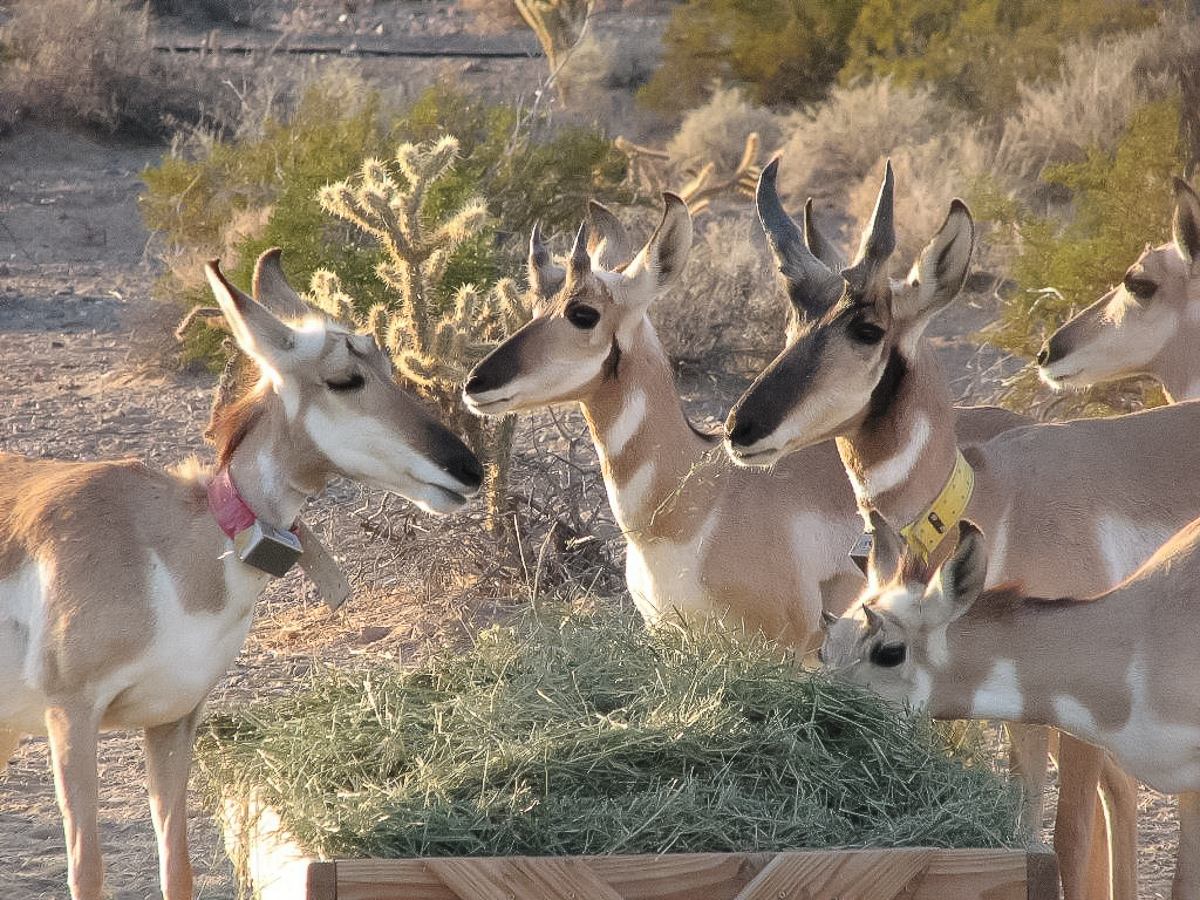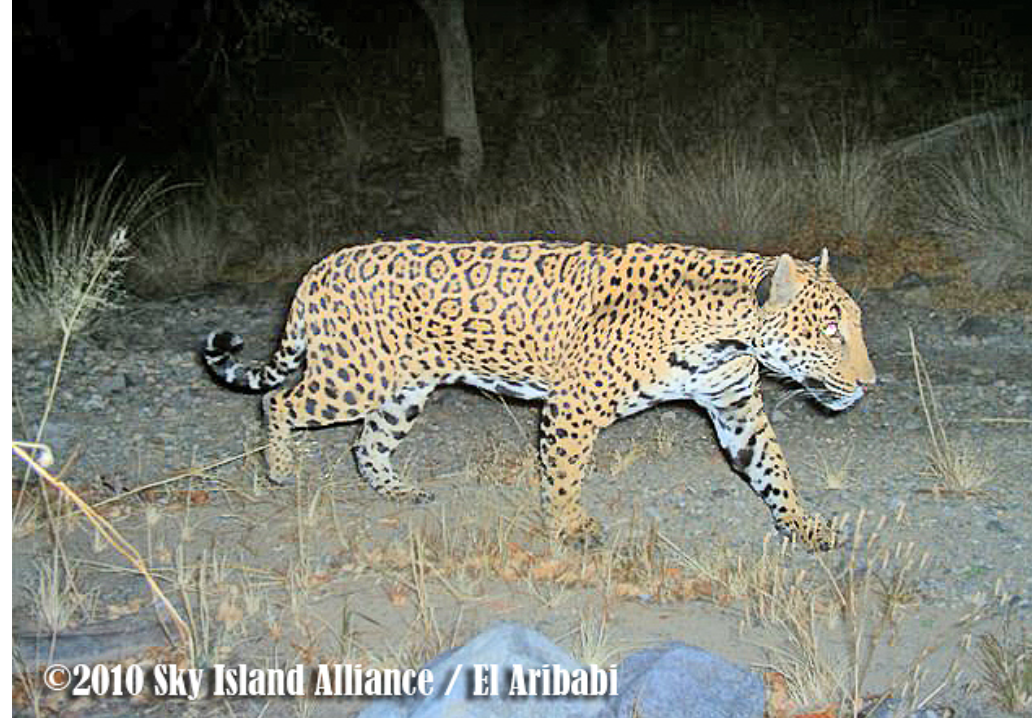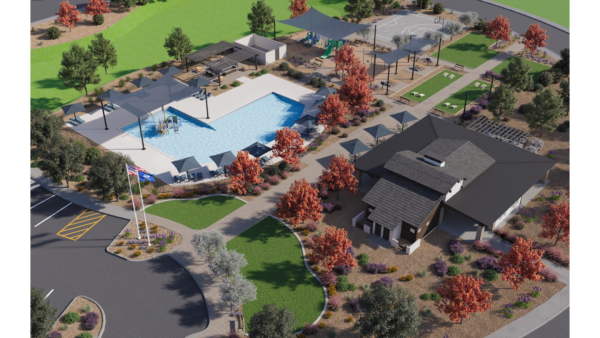President Trump wants to stop illegal immigration with a wall along the U.S.-Mexico border, but experts agree it would harm the ecology of one of the most biodiverse regions of North America.
By Megan Janetsky | Arizona Center for Investigative Reporting
 or more than a year, then-candidate Donald Trump promised voters at rallies, in tweets and on debate stages that America’s very safety and sovereignty had been compromised, and the only solution was to build a wall on the porous and unprotected U.S.-Mexico border.
or more than a year, then-candidate Donald Trump promised voters at rallies, in tweets and on debate stages that America’s very safety and sovereignty had been compromised, and the only solution was to build a wall on the porous and unprotected U.S.-Mexico border.
In his first year in office Trump issued an executive order calling for “immediate construction of a physical wall on the southern border,” and prototypes have been constructed near San Diego. But despite Trump’s vow that Mexico would pay for it, funding the project has so-far proved elusive. In just the past week, Trump maintained that Mexico will “in some form” pay for the wall, but also requested $18 billion from Congress to cover the costs, as part of a deal that would also allow DACA (Deferred Action for Childhood Arrivals) recipients to stay in the U.S.
Whether a wall would actually provide the border security Trump promised, experts across state and federal agencies and conservation organizations warn that the proposed wall would certainly disrupt sensitive wildlife habitats, bringing severe consequences to several species.
Scientists say one area that would be most affected is the Madrean Sky Islands, a cluster of more than 60 high-elevation mountains rising out of lowland valleys that runs from southern Arizona and New Mexico into Mexico. Home to 7,000 species, many endangered, researchers call it one of the most biodiverse areas in North America.
Predatory mammals like black bears, ocelots, Mexican gray wolves, and jaguars roam from mountain to mountain. Smaller species like the barred tiger salamanders, lesser long-nosed bats and desert tortoise inhabit distinct ecosystems within the mountain ranges.
Adding new physical barriers along the southern border would escalate habitat fragmentation – dividing a species’ natural habitat, leading to isolated and weaker population fragments. Ultimately, researchers say, a border wall could lead to destabilization or extinction.
The Sky Islands’ river corridors, mountains and grasslands act as a highway of animal migration between the two countries.
The region is currently bisected by a mish-mash of vehicle barriers, wire and pedestrian fencing that make up the border infrastructure. Because of the on-and-off fencing, some species have already felt the effects cutting off migration patterns could have.
Aaron Flesch, a University of Arizona researcher who has worked along the border since 1996, said the long-term impacts are hard to predict, but the negative consequences are certain.
“Cutting off connectivity, in almost all cases, is going to be bad,” Flesch said. “We don’t know if it’s necessarily going to cause extinction of either sub-population on either side of the border, but it’s definitely going to (increase) the probability of it.”
But researchers have identified the effect of existing man-made barriers on species’ abilities to find food, water and mates along the border.
Mexican Federal Highway 2, which closely parallels the U.S.-Mexico border and spans 1,219 miles, from Tijuana in Baja California to Playa Bagdad in Tamaulipas, has proved impassable for some species.
The highway presents a case study in what Trump’s “big, beautiful wall” would mean for many species along the border, scientists say.
Part of the highway borders the southern edge of Arizona’s Cabeza Prieta National Wildlife Refuge, fragmenting the habitat of the Sonoran pronghorn, one of the most endangered species in the region.
The highway, along with two others bordering the refuge, irreparably harmed the ability of pronghorns to naturally recover from environmental stressors like droughts and erosion, cutting them off from water and food, and limiting genetic diversity, according to researchers and reports detailing species recovery efforts.
Jim Atkinson, the Sonoran pronghorn recovery coordinator for the wildlife refuge, said the species would have gone extinct were it not for extensive bi-national recovery efforts – at the cost of tens of millions of dollars – by both the U.S. and Mexico.
“They’re very nomadic and they could pretty much wander wherever they needed to go seasonally,” Atkinson said. “It’s all driven by, where’s the water and where’s the food? Now, we’ve got a landscape like Cabeza (Prieta) that’s defined by highways.”
And Arizona wildlife would be affected more than other border states, researchers say, because many of the existing barriers along the state’s section of the border still allow some animals to cross.
Of the 376 miles that make up the Arizona-Mexico border, 142 are lined with various kinds of pedestrian fencing, or fence structures designed to stop border crossers traveling by foot, according to information provided by U.S. Customs and Border Protection. Another 183 are lined with vehicle barriers, made up of metal posts – sometimes crosshatched – and designed to stop cars from driving over border terrain. Only 51 miles have no barrier.
Vehicle barriers, which line about half of the Arizona border and allow most species to cross, have been placed along some portions of the Sky Islands section of the border. But in other parts of the Sky Islands, wildlife movement has been inhibited by more obtrusive fencing.
“A lot of the populations in the borderlands of Sonora seem to be dependent on movement in southern Arizona,” Flesch, the UA researcher, said.
When a species is divided by a barrier, and a catastrophic event, like fire or flood or drought, diminishes the population, Flesch said, the divided species faces a more difficult recovery, and risks a greater chance of extinction.
‘We’re altering the whole food system’
Researchers working for the Tucson-based Sky Island Alliance want to more definitively demonstrate what effect a wall would have on the wildlife in the Sky Islands.
“An impassable border wall would make it very difficult for a lot of species to live in this area to continue to exist,” Bryon Lichtenhan, one of the group’s field coordinators, said.
The group had already placed motion-sensor cameras in some areas of the Sky Islands, further from the border, to study specific wildlife groups and areas. In July, they moved the cameras to border-crossing passages in areas of the Patagonia and Huachuca mountains, where researchers suspected they would find rarer species that haven’t been directly observed.
Sky Island wildlife
Motion-sensor cameras placed in the Madrean Sky Islands capture the variety of animals in the region. /From top to bottom: Bobcat, Jaguar, Mountain Lion, Caoti, Javelina, Black Bear; /Photos courtesy of Sky Island Alliance







After finding paw prints left in the sand by a large cat, wildlife trackers Kelly Haven and Bryon Lichtenhan look for more along a nearby river bank. The area is often used by migrating wildlife. /Photo by Megan Janetsky/AZCIR
Lichtenhan and the other Sky Island Alliance researchers want to show the public what species, and how many, are passing through the region.
The researchers reviewed and downloaded images from the cameras for the first time in October. They had captured images of more common species, like javelinas and deer, but not the less documented ocelot, Mexican grey wolf or jaguar.
“Scientifically, we can (demonstrate) that animals are moving around,” Lichtenhan said. “But it’s not the same as being able to show a picture of an animal that just walked across the border into the U.S.”
Scott Wilbor, conservation science director for the Sky Island Alliance, said a impassable barrier could result in extirpation – an area-specific extinction – of top-of-the-food-chain predators that have a regulating effect on the ecosystem, which could lead to a “cascade of impacts.”
“We’re altering the whole food system when we start removing these species from the ecosystem,” Wilbor said. “We’re still learning about that.”
Wilbor and other scientists said they don’t have a clear sense of what the effects of border barriers would be on the wildlife, in large part, because of a federal law known as the Real ID Act of 2005.
A provision of the Real ID Act allows the U.S. Secretary of Homeland Security to “waive all laws as necessary to ensure expeditious construction of certain barriers and roads at the U.S. border.”
Between 2005 and 2008, the Real ID Act was used five times under President George W. Bush to waive 37 environmental laws and regulations and construct border fencing, Department of Homeland Security records show. Between 2009 and 2016, the exemption was not used.
Three waivers were used in Arizona. In 2007, one was used in the San Pedro Riparian National Conservation Area in the Sky Islands, near the area where Lichtenhan and researchers placed cameras.
Among the laws waived were the Endangered Species Act and National Environmental Policy Act (NEPA), which requires the federal government to conduct a “comprehensive review of potential environmental impacts” before making any decision.
In January 2017, President Trump signed an executive order charging DHS with increasing border enforcement and begin “immediate construction of a physical wall on the southern border.” In order to expedite construction of border wall prototypes and fencing replacements in San Diego, DHS restarted the use of the waiver in August.
“Notwithstanding the waiver, CBP will implement sound environmental practices as part of the projects covered by this waiver,” Diaz said. “CBP is committed to the protection of the environment in areas in which we work and live.”
However, Diaz explained “CBP no longer has any specific legal obligations under the laws that are included in a waiver,” since the waiver relieves the agency of complying with NEPA requirements.
And because there are no explicit standards provided as an alternative when a waiver is used, Diaz said CBP will simply, “continue to conduct appropriate environmental surveys of the project area and work in a collaborative manner with local governments, state, and federal land managers, and the interested public to assess potential impacts and identify environmentally sensitive resources.”
CBP previously worked with local, state, federal and tribal governments to carry out environmental surveys on border construction projects, under what the agency refers to as the Environmental Stewardship Program. But the program is voluntary and lacks the detailed requirements of NEPA, which means the analyses can be incomplete, some researchers say.
A ‘mini Jurassic Park’
Every few days since 2008, Jim Atkinson, a wildlife biologist for the U.S. Fish and Wildlife Service, has driven to a set of pens in the northeastern corner of the Cabeza Prieta National Wildlife Refuge, near Ajo, Arizona. He uses binoculars to observe the Sonoran pronghorns from mountains and camoflauged watchtowers surrounding the pens, which he calls “a mini Jurassic Park,” so that he doesn’t disturb them.
The simulated habitats, two adjacent but separated square-mile enclosures, contain the pronghorns, one of the most endangered species in North America. A 6-foot-high fence encircles each pen. The entire structure is surrounded by another 7,000-volt fence. Inside, the pronghorns have access to watering holes and feeding stations, and researchers can observe the animals from observation towers overlooking each pen.

Jim Atkinson, Sonoran pronhorn recovery coordinator, scans the Cabeza Prieta National Wildlife Refuge near Ajo, Arizona, searching for herds of pronghorns. /Photo by Megan Janetsky/AZCIR
Found only in southwest Arizona and northern Mexico, the species once moved freely between the United States and Mexico, but man-made barriers have prevented its movement across the border and within the U.S.
Mexican Highway 2, Arizona Route 85 and U.S. Interstate 8 divided the natural pronghorn habitat into a handful of smaller, more vulnerable and genetically less diverse groups. Researchers have observed that the pronghorns generally don’t cross paved roads, and keep away from traffic. Fences lining both sides of Highway 2 create an additional barrier for the pronghorns.
Because no pronghorns could reach the full extent of the range, if a drought affects one area, then pronghorns in that area cannot get to areas not affected. Droughts similarly lead to food shortages, having a similar effect. And the divided populations of pronghorn groups inbreed, because they lack contact with the full population.
“When Highway 2 was put in, it was the big, hard and fast barrier that was going to prevent any more linkages and movement between the group in Arizona and the group in Sonora,” Atkinson said.
In 2002, the U.S. pronghorn population dwindled to 21.
The population, now at 230, narrowly avoided extinction in the U.S. as a result of extensive recovery efforts by both the Mexican and U.S. governments, Atkinson said.
“If we had done nothing, we would have stood a pretty good chance of losing the animal,” he said.
By 2020, federal, state and local governments on both sides of the border will have spent more than $27.3 million to research the species and its habitat, maintain water holes and pens and combat the lack of genetic diversity by transporting groups of pronghorns across the man-made barriers using trailers and helicopter – all an attempt to save the species.
Because so much human intervention aimed at saving the species already exists, Atkinson and the refuge manager, Sid Sloan, said they don’t believe the border wall would affect them.
“For Sonoran pronghorn recovery, given the barrier we have, I don’t think a wall would make that much difference,” Sloan said.
In areas like the Sky Islands, many species could face the same fate as the pronghorn.
“That’s kind of an early indication of what could happen elsewhere if you close those connections,” Scott Wilbor, the Sky Island Alliance conservation science director said.

Jim Atkinson, a Sonoran pronghorn recovery coordinator, points out the pronghorn habitat prior to the construction of highways that divided it. /Photo by Megan Janetsky/AZCIR

Sonoran pronghorn in the Cabreza Prieta National Wildlife Refuge /Photo courtesy of Cabeza Prieta National Wildlife Refuge

Bryon Lichtenhan, Scott Wilbor and Kelly Haven (left to right) traverse the Patagonia Mountains to check the photos captured by motion-sensor cameras they placed in the area. /Photo by Megan Janetsky/AZCIR
Limited scientific study
Because the current fencing was built without a full environmental analysis, researchers believe hundreds of smaller species – not just the endangered species and larger animals like the jaguar, black bear or ocelot, which have garnered national attention – may be wiped out.
Jesse Lasky, a biologist from Penn State University, led a 2011 study on the effects of border fences, and on what more “extensive barriers” would mean.
“The attention of the public is focused on these large, charismatic species,” Lasky said.
While scientists have studied the effect of barriers on specific species, like the bighorn sheep or the ferruginous pygmy owl, Lasky’s research considered the border in its entirety.
Lasky found that 369 species lived within 50 kilometers of the border: 179 reptiles, 134 mammals and 57 amphibians. At that time, 50 of those species and three subspecies were federally or globally threatened, he found.
When the researchers examined the potential effects of “extensive barriers,” like a non-permeable border wall along the entire U.S.-Mexico border, the number of species put at risk in the Sky Islands increases dramatically relative to other parts of the border.
Wilbor and his team at the Sky Island Alliance want to know what species could face extinction without federal intervention, where they dwell and what effect a border wall would have. That’s why they set up new cameras in areas along the border, where they believe they’ll find and identify those animals.
“There are rare and threatened and endangered reptiles – snakes, lizards, tortoises – we know a lot less about because they’re not game species, they’re not large species that are easy to study,” Wilbor said. “There could be innumerable small species that go extinct without us even knowing.”
Previous studies using motion-sensor cameras in the Sky Islands have captured images of black bears, ocelots, javelinas, jaguars, coati and mountain lions, often moving through the region at night.
Wilbor said the researchers put the new cameras in areas along the border where the species have not yet been spotted, like streambeds the animals use, and near the permeable vehicle barriers, where animals can still pass but where they have been diverted due to more restrictive pedestrian barriers in other areas.
The data gathered from the cameras will be shared with land managers and biologists who lead conservation efforts in Sky Islands – a mix of protected and unprotected, private and public lands.
“We know the impacts, element by element, but we don’t know the cumulative impact,” Wilbor said. “And that’s going to take a while to play out.”
In April, the Center for Biological Diversity and U.S. Rep. Raúl Grijalva, D-Tucson, filed a federal lawsuit against DHS and Customs and Border Protection. The suit alleged that an environmental analysis of a wall by the federal government is necessary because it would have “environmental impacts far larger in scope, extent, and intensity” than previous border construction.
Brian Segee, an attorney for the Center for Biological Diversity’s Endangered Species Program said construction has had a “devastating impact” on the sensitive environments of the southwest border. He said that a federal analysis is needed, especially for more extensive barriers.
“These environmental laws, they don’t only impact the environment,” Segee said. “National Environmental Policy Act, in particular, provides a way for the federal government to take a broader look at it’s actions.”
The Department of Homeland Security and U.S. Customs and Border Protection declined to comment on pending litigation.
Most recently, a May 2017 report by the Center for Biological Diversity analyzing data from the U.S. Fish and Wildlife Service identified 93 threatened, endangered and candidate species that would be harmed by the construction of a wall.
Of those, the U.S. Fish and Wildlife service lists 57 as endangered, and 24 others as threatened. Three other species are proposed for endangered status, three are candidate species, four are under review for protection, and two are species of concern.
Of the 93 species, 40 live in Arizona and 25 have federally designated critical habitat along the border, U.S. Fish and Wildlife Service records show.
All but five have have ranges that extend along both sides of the border, the report shows.
“We don’t have as much information as we should, because the laws haven’t been complied with, which, in turn, affects the stream of funding that would go to researchers and agencies if they would be required, as they would typically be, to better monitor and mitigate,” Segee said. “It’s another consequence of lawless border wall construction.”












